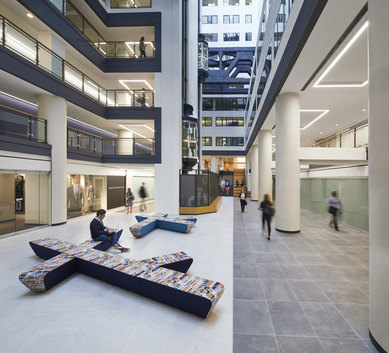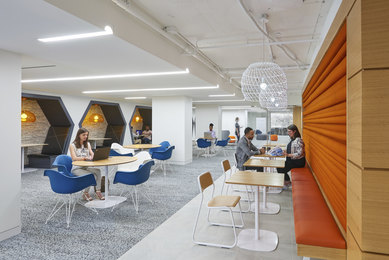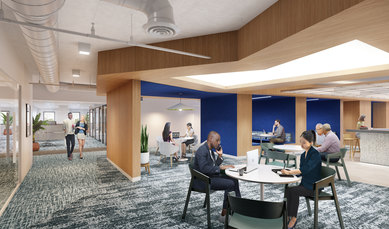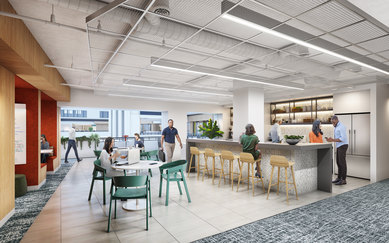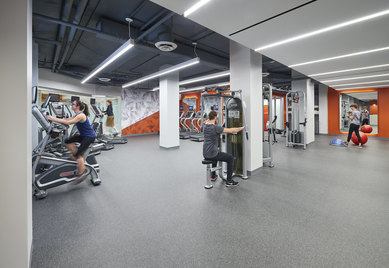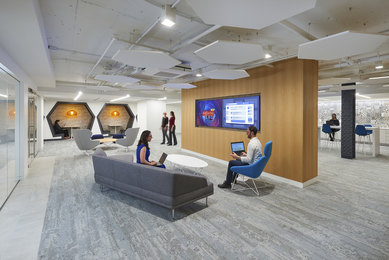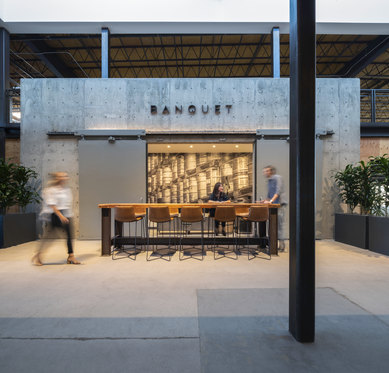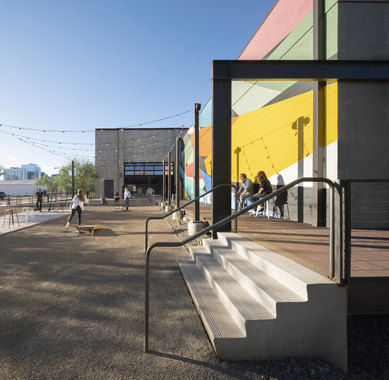Redefining Co-Working in a Post-COVID World
This article was previously published in Work Design Magazine.
In 1995, Berlin, Germany gave rise to the creation of “hackerspaces,” a novel new type of workspace that inspired Brad Neuberg, a young software engineer, to coin the term “co-working” and open the world’s first official co-working space in San Francisco a decade later. Today, co-working is defined as an arrangement in which workers of different companies share an office space, allowing cost savings and convenience through the use of common infrastructures, such as equipment, utilities, receptionist, and custodial services, and in some cases refreshments and parcel acceptance services.[1] After a bit of a slow start, the concept took the office market by storm, roughly doubling the number of co-working spaces and members within a decade. By 2019, there were nearly 20,000 co-working spaces in operation, with more than half located in the Asia Pacific, followed by Europe, the Middle East, Africa, and the United States. The U.S. alone accounted for nearly 80 million SF of co-working space.
In early 2020, the greatest unplanned remote work experiment ensued, sending millions of workers away from the office to work from home. However, despite the negative market impacts from COVID-19, research shows that co-working will weather the storm and will likely experience a surge in popularity following the pandemic. The Commercial Observer estimates coworking spaces are likely to double or triple in the U.S. in the next five years. JLL predicts 30% of all office space will be consumed flexibly by 2030. [2] The Global Coworking Growth Study estimated that approximately 5 million people will be working from co-working spaces by 2024, an increase of 158% compared to 2020. [3]
As COVID-19 fueled the knowledge workers’ desire for more flexibility in terms of where and how to work, co-working is primed and ready for another evolution. Below we’ll discuss three advancements the co-working concept will experience in the following decade.
Company Co-Working
Although the term co-working is broadly defined as space for workers from different companies, that isn’t the critical measure of success. Over the last decade, the office market along with corporate end users have slowly adopted activity-based and agile workplace strategies. According to a recent study, 67% of CRE decisionmakers are increasing workplace mobility programs and incorporating flexible space as a central element of their agile work strategies.[2] Company co-working expands these same strategies across multiple locations, giving employees additional choice in which office location works best for them on any giving day/week/month. Major companies diving into coworking offerings for their employees include American Express, Verizon, McKinsey & Co, and Merck.
And this trend doesn’t apply to just private business. Major governments around the world are also making the shift. In the United States, the General Services Administration (GSA), with over 400 federal government agencies, published a solicitation in January of 2020 for Flexible Coworking Services in which “GSA is seeking nationwide Flexible Coworking Services (FCS) solutions that provide federal employees with flexible workspace solutions in order to occupy only the space needed in order to meet their missions and promote a responsible use of taxpayer dollars.” As the largest office tenant in country, you can understand the draw to maximizing space and providing their employees space when and where it’s needed most. For agency and/or company leaders, this approach provides the security, access, and technology it needs for productive work alongside the flexibility the employees’ desire.
Flexible Suites & Co-Working
Landlords and developers across the country are dealing with rising vacancy rates and declining asking rents as companies try to discern their approach to in-office work post-pandemic. With vacancy rates hovering around 12% pre-pandemic and now holding steady 16%, the competition for tenants continues to rise steadily. Repositioning projects in major markets hope to lure new tenants with amenities including outdoor workspaces, rooftop decks, fitness centers, conferencing/training centers, event space and now co-working environments.
The mix of the traditional office building programs will no longer be two-pronged and based solely on tenant spaces and amenities. Flexible suites, spec suites, and co-working spaces will continuously be added to the mix in an attempt to off-set the negative impacts from the pandemic and create a secondary customer base. How important will co-working be in the office mix in 2022 and beyond? In a recent CBRE study, 86% of respondents see flexible office space as a key component of their future real estate strategies.[4]
Patrick Keeley, Senior Vice President at Columbia Property Trust, shared that all of the variations of pre-built space options remain best suited for smaller tenants (under 10,000 sf), as larger tenants typically want more control as to how the space is built out. “Markets with larger tenants likely won’t see as much of this product built speculatively by landlords.” He noted, “currently we’re seeing a number of tenants that let office space go during COVID-19 come back to the market seeking immediate occupancy—days to weeks after signing the lease. The only viable option for these customers is pre-built spaces and suites.”
In Washington, DC, Columbia Real Estate Management (a subsidiary of Columbia Property Trust) had difficulty leasing larger units in one of its managed properties, the 558,500 SF National Press Building. Columbia decided to pivot and convert an entire floor to flex office space. In this case, their new offering dubbed “The Nexus” will provide independent office space with access to a fully amenitized floor as well as a top-of-the-line fitness center, tenant lounge, café and conferencing facility put in place pre-pandemic.
Maria Blake, Vice President, Real Estate for Columbia Property Trust explains further, “As a building with a lot of small tenants, we were losing deals to co-working providers. However, the market had become so saturated with co-working, we felt we couldn’t compete directly. At the same time, tenants were growing out of co-working solutions and looking for secure spaces they could call their own but with high-end amenities and collaborative spaces they had found so appealing in co-working environments. These tenants need move-in ready spaces with flexible terms but want something that feels more like a home. We had spec suites, but they weren’t enough to satisfy that niche. We had to provide something more. So, when one of our major tenants relocated to a larger space giving us a full floor vacancy, we took the opportunity to convert that entire floor into a flexible office space offering called The Nexus. We now have 21 suites ranging from 281 SF to 3,800 SF surrounding open collaborative work areas, lounges, oversized pantries, huddle rooms and conference rooms. The offering has been so successful that we are working on expanding this concept and rolling it out to several other buildings in our managed portfolio.”
Community Co-Working
As companies across the country implement various levels of remote and hybrid work, approaches to real estate will also evolve. Consolidations and utilization/right-sizing exercises will force companies to determine the true cost benefit of providing physical office space. On the other side, employees recouped hours and hours of commute time per week during the pandemic, so the notion of working in and commuting to an office Monday through Friday might be a difficult pill to swallow post-pandemic. In some instances, particularly in large urban markets, a hub and spoke approach—where companies offer a central hub or headquarters coupled with a network of smaller, regional offices closer to where employees reside—might be the most viable solution. Depending on the organization type and size, operating multiple office spaces in a region, instead of one, will be worth it. However, other organizations that want to benefit from the upsides of this model but don’t want to manage and operate more real estate will turn to community co-working offerings.
Location Spurs Popularity
“Certainly, location will play a large role in influencing the speed at which co-working is adopted as a viable real estate offering,” says Mark Adams, Workplace Studio Leader at SmithGroup’s Phoenix office. “For instance, regions that have become home to tech companies and start-ups may see a rise in these spaces and modalities sooner and more readily than areas that support more hands-on operations like manufacturing, research and development or related industries.”
In recent years, Phoenix has become a popular destination for a growing number of technology-based and start-up enterprises and is attracting a new workforce. As a result, the city has seen rising demand for co-working spaces. In 2019, SmithGroup completed the first phase of Lincoln Union, an adaptive reuse project that converted more than 93,000 sf of former warehouse space into shell space tailored for single or multi-tenant spaces. Most recently, interior amenity additions were made to attract either potential long-term tenants or co-working opportunities. These high-end amenities, collaborative spaces, multi-functional outdoor zones, and more were built for enticing a variety of tenant types. A second phase is planned for future build-out.
“COVID-19 helped organizational leaders to see that employees can remain productive even when working from a distance,” says Adams. “As a result, companies are starting to explore new possibilities regarding where and how to operate. As industries continue to evolve and move into new geographic markets, co-working scenarios are likely to grow, too.”
Closing
While organizations are still assessing how co-working will fit into their work strategies moving forward, the benefits that come from offering employees a new model and space for accomplishing work-related tasks are hard to overlook. As we partner with clients to assess and plan for their evolving real estate and space needs, SmithGroup’s workplace strategists and office design leaders assert that shared workspaces and co-working opportunities will continue to gain in popularity, becoming strong, essential components that support a company’s business and facility needs. The pace at which this evolution continues is still to be determined.
[1] Babb, Courtney; Curtis, Carey; McLeod, Sam (2018-10-02). "The Rise of Shared Work Spaces: A Disruption to Urban Planning Policy?". Urban Policy and Research. 36 (4): 496–512.
[3] Global Coworking Growth Study 2020
[4] CBRE: Flex Office Sector to Emerge as a Key Component in Evolution of Workplaces
